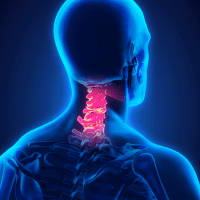Mastering Pain Relief: Essential Guide to Cervical Herniated Disc Symptoms and Treatment
Welcome to a comprehensive exploration of cervical herniated disc, a condition that may be the root of your neck discomfort, arm numbness, or weakness. Leading this insightful journey is Dr. Matthias Wiederholz, MD. As a board-certified pain management specialist, Dr. Wiederholz brings a wealth of knowledge and an unparalleled expertise to the table. His practice, Performance Pain and Sports Medicine, is renowned for its innovative and patient-centric approach to pain relief and sports medicine.
In this article, we delve into the intricate world of cervical herniated discs, guided by Dr. Wiederholz’s extensive experience. We aim to shed light on the symptoms that should not be ignored and explore a spectrum of effective treatments. Dr. Wiederholz’s philosophy revolves around a holistic approach, blending cutting-edge, non-invasive techniques with minimally invasive procedures. His commitment to excellence and patient well-being makes this guide an invaluable resource for anyone seeking to understand and conquer cervical herniated disc-related pain..
Key Takeaways
- Understanding Cervical Herniated Discs: This condition occurs when the gel-like center of a spinal disc protrudes through its outer wall. It’s often a result of age-related degeneration, genetic predisposition, or physical strain. Key symptoms include neck pain, arm pain, numbness, and muscle weakness.
- Non-Surgical Treatments: Initial management often involves medications such as NSAIDs and muscle relaxants. Physical therapy plays a crucial role in reducing pain, alleviating pressure on spinal nerves, and enhancing functional movement.
- Minimally Invasive Procedures:
- The Discseel® Procedure: An innovative treatment that repairs and seals spinal disc tears, offering a potential alternative to more invasive surgeries.
- Epidural Steroid Injections: These injections deliver steroids directly to the epidural space to reduce inflammation and pain.
- Endoscopic Discectomy Procedure: A less invasive method that involves the use of an endoscope to remove or treat the damaged disc.
- Intrathecal Pain Pump: This device delivers pain medication directly to the spinal cord, offering targeted pain relief with minimal systemic side effects.
- Surgical Treatments as a Last Resort: When non-surgical methods and minimally invasive procedures do not provide sufficient relief, surgical options may be considered. These include Anterior Cervical Discectomy and Fusion (ACDF) or artificial disc replacement. These procedures involve the removal of the damaged disc and, if necessary, the insertion of an artificial disc or bone graft to alleviate symptoms. However, they are typically pursued only after exhausting less invasive treatment options.

Understanding Cervical Herniated Discs
The cervical spine, or neck, consists of seven vertebrae (C1-C7) cushioned by discs that facilitate movement. A cervical herniated disc occurs when the disc’s gel-like center protrudes through a weakened area in its outer layer, causing discomfort and pain.
This condition often results from a mix of factors, including age-related wear and tear, genetic predisposition, and physical strain, such as improper lifting. As we age, our discs dehydrate and weaken, increasing the likelihood of herniation. This can lead to a bulge or rupture in the spinal canal, resulting in pain and other symptoms like nerve irritation, potentially leading to significant discomfort.
Anatomy of the Cervical Spine
The cervical spine’s intricate design is highlighted by the craniocervical junction (CCJ), comprising the first two vertebrae (C1, C2) and the occiput at the base of the skull. This junction is crucial for protecting the spinal cord as it exits the skull. The discs between each vertebra in this area are vital, acting as both shock absorbers and supportive structures. They enable slight movements and reduce stress on the spine.
These discs are uniquely constructed with a tough outer layer and a flexible, gel-like center, allowing them to efficiently absorb shocks and protect delicate components like spinal nerves. Their composition is key to maintaining the spine’s integrity, ensuring fluid motion for head movements, and safeguarding nerve pathways that connect various regions along the spine.
Causes of Cervical Disc Herniation
Cervical disc herniation is primarily caused by age-related degeneration and genetic factors. Physical strains from demanding jobs or activities, especially those involving neck strain, bending, and heavy lifting, also contribute significantly.
These factors can lead to the disc’s soft center pushing through its outer layer, causing neck discomfort. Understanding these risks is key to adopting preventive measures against disc herniation.
Identifying Symptoms of Cervical Herniated Discs

Recognizing the signs and symptoms of cervical herniated discs, also referred to as slipped discs, is crucial for early detection and effective treatment of this type of cervical disc disease. One common symptom associated with a herniated cervical disc is neck pain. There may be additional indicators if the affected disc puts pressure on a nerve root.
Muscle spasms are often triggered by a cervical herniated disc which can cause muscle tightness, arm numbness or tingling sensation along with weakness in various muscles such as biceps, triceps and hand grip. Familiarity with these warning signs can aid in identifying potential instances of having an issue related to your cervical spine’s intervertebral discs promptly so that appropriate medical intervention can be sought out without any delays.
Neck Pain and Muscle Spasms
In the case of cervical herniated discs, pain in the neck is often caused by inflammation and swelling of spinal nerves due to pressure from a disc. This can also lead to muscle spasms which are characterized by involuntary tightening and persistent discomfort in the neck, arm, and hand.
Muscle spasms are a common occurrence with cervical herniated discs causing symptoms such as electric-like pain spreading towards these areas along with numbness. These effects usually last for approximately 6 weeks among patients suffering from this condition.
Radiating Arm Pain, Numbness, and Weakness
Pain, numbness, and weakness in the arm can be signs of nerve compression caused by a herniated disc. These neurological symptoms are often associated with cervical disc herniation due to direct pressure on nerve roots and inflammation.
Cervical disc herniation is a common cause for arm numbness and weakness, occurring at an estimated rate of 1.79 per 1,000 people each year. The nerves in the spine and their roots are frequently affected by this condition, which results in these particular sensations. It’s crucial not to disregard such warning signs as they may indicate a cervical herniated disc requiring medical attention.
Diagnosing Cervical Herniated Discs

After the identification of symptoms associated with a cervical herniated disc, the next step is to diagnose the condition. This typically involves conducting a physical examination that includes:
- Assessing sensory and motor disturbances
- Testing deep tendon reflexes
- Conducting Spurling test to detect any signs of cervical radiculopathy
- Palpating for indications of swelling, tenderness or discomfort in the neck area
-Evaluating range-of-motion in the neck region.
The presence of certain indicators may suggest a possible diagnosis of a cervical herniated disc. These factors include being over 50 years old, prolonged use of corticosteroids, and history.
Physical Examination and Red Flags
Conducting a thorough physical examination is crucial in diagnosing cervical herniated discs. This involves carefully feeling the neck for any signs of swelling, tenderness or discomfort, assessing its range of motion and checking for neurological issues such as reflex irregularities, numbness and muscle weakness in the arms.
To Assess cervical herniated discs during a physical exam, certain movements and tests may be performed including:
- A neurologic assessment to identify sensory abnormalities and muscle weakness.
- The Spurling test which evaluates the condition of the cervical spine.
- Cranial cervical flexion test that detects coordination impairments in movement.
- And finally, testing endurance levels of neck flexor muscles.
These specific examinations are important tools used to diagnose and evaluate cases involving cervixal herinated disc conditions.
Imaging Studies
Cervical herniated discs can be diagnosed through a combination of physical examination and imaging studies. The most commonly used non-invasive method for diagnosis is an MRI, with an accuracy rate of over 95% in detecting cervical disc problems.
While a CT scan can also identify signs of cervical disc herniation and other structural irregularities, it has lower sensitivity compared to the MRI specifically for identifying herniated discs. In some cases, contrast agents may be utilized to obtain a more comprehensive evaluation of cervical disc issues.
Non-Surgical Treatment Options for Cervical Herniated Discs

Upon confirming a cervical herniated disc diagnosis, treatment typically begins with non-surgical methods. These include medication, pain management techniques, and physical therapy.
Medication and Pain Management:
Medications such as ibuprofen, naproxen, or aspirin are often recommended for managing pain. For more severe symptoms, muscle relaxants, anti-inflammatory drugs, and nerve pain relievers like amitriptyline, duloxetine, gabapentin, pregabalin, and tramadol may be prescribed. While these medications can be effective, it’s important to be mindful of potential side effects, such as drowsiness, dry mouth, constipation, and weight gain.
Physical Therapy and Activity Modifications:
Customized physical therapy programs are crucial in treating cervical herniated discs non-surgically. These programs focus on restoring normal movement, reducing pain, and enabling patients to resume daily activities. Exercises like neck rotations, rehabilitative exercises, and chin tucks are beneficial for strengthening neck muscles and supporting the cervical spine.
Minimally Invasive Procedures for Cervical Herniated Discs
The Discseel® Procedure:
The Discseel® Procedure is a revolutionary treatment that addresses spinal disc tears, a common cause of back and neck pain. This procedure involves the injection of a natural, biologic substance, similar to fibrin, into the damaged disc. The substance seals the tears and promotes healing within the disc. Unlike traditional surgical methods, the Discseel® Procedure is minimally invasive, does not require removal of the disc, and aims to preserve the natural biomechanics of the spine. Patients typically experience significant pain relief and improved mobility, with a shorter recovery time compared to conventional surgery.
Epidural Steroid Injections:
Epidural steroid injections are a common minimally invasive treatment for pain associated with cervical herniated discs. This procedure involves injecting a corticosteroid, often combined with a local anesthetic, directly into the epidural space surrounding the spinal cord and nerves. The steroid reduces inflammation and swelling, providing significant pain relief. The procedure is relatively quick, performed under local anesthesia, and patients can often return to their normal activities shortly after. While not a permanent solution, these injections can provide temporary relief and are particularly useful in managing acute pain episodes.
Endoscopic Discectomy Procedure:
The Endoscopic Discectomy Procedure is a minimally invasive surgical option for treating cervical herniated discs. This technique uses a small endoscope, inserted through a tiny incision, to access and visualize the affected disc. Surgeons then remove or treat the herniated portion of the disc, alleviating pressure on the spinal nerves. The procedure offers several advantages, including reduced muscle damage, minimal scarring, and a quicker recovery time compared to open spine surgery. It’s particularly beneficial for patients who have not responded to conservative treatments and are seeking an alternative to more invasive surgeries.
Intrathecal Pain Pump:
An Intrathecal Pain Pump is a device used to deliver pain medication directly to the spinal cord. This method is particularly effective for patients with chronic pain conditions, including those stemming from cervical herniated discs. The pump, implanted under the skin, releases a controlled amount of medication into the intrathecal space, providing continuous pain relief. This targeted approach allows for lower doses of medication, reducing the side effects often associated with oral painkillers. The pump’s dosage and schedule can be adjusted according to the patient’s specific pain management needs. It’s a viable option for patients who have not found relief through other treatments and are looking for a long-term solution to manage their pain.
Surgical Treatment Options for Cervical Herniated Discs

Surgical intervention is considered when non-surgical and minimally invasive methods are insufficient. The primary surgical techniques are Anterior Cervical Discectomy and Fusion (ACDF) and artificial disc replacement. Recovery from these surgeries varies, typically involving several weeks of rest before resuming basic activities.
Anterior Cervical Discectomy and Fusion (ACDF): This surgery involves removing the affected disc and stabilizing the area, often using a bone graft or artificial spacer. While effective, it carries potential risks like bleeding, nerve damage, and infection.
Artificial Disc Replacement: This procedure replaces the damaged disc with a synthetic one, preserving natural motion in the cervical spine. It’s an alternative to ACDF, eliminating the need for a bone graft.
Surgical options are generally considered a last resort, pursued only after exploring all non-surgical and minimally invasive treatments.
Preventing Cervical Herniated Discs
Prevention is always better than cure, especially when it comes to cervical herniated discs. Keeping a healthy weight can help prevent these conditions by reducing strain on the spine and strengthening supporting muscles.
Proper management of symptoms related to cervical herniated disc includes regular exercise, stress reduction techniques, maintaining good posture, practicing proper sleep habits, and using heat/ice therapy. It’s also important to use correct lifting techniques like utilizing leg strength instead of twisting movements and using assistive tools for heavy objects.
These strategies are essential in evenly distributing body weight and decreasing spinal pressure, both crucial factors in preventing cervical herniated discs from occurring or worsening.
Summary
Neck pain from cervical herniated discs, while common, can be effectively managed with the right knowledge and treatment strategies. Early recognition of symptoms and timely treatment are key to preventing the condition’s progression.
At Performance Pain and Sports Medicine, we understand the challenges of living with a herniated disc. That’s why we offer a range of minimally invasive procedures at our Houston, League City, and Lawrenceville locations. Dr. Matthias Wiederholz specializes in the Discseel® Procedure, available in both Houston and Lawrenceville, providing a cutting-edge option for those suffering from disc-related discomfort.
Furthermore, Dr. Wiederholz extends his expertise through the BICMD platform, offering medical advice to those in need. Armed with accurate information, expert care, and advanced treatment options, you can overcome the challenges of a herniated disc and lead a fulfilling life. Remember, taking control of your health today can lead to a future free from the discomfort of cervical herniated discs.

















